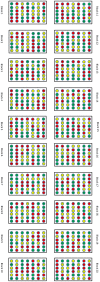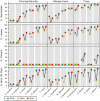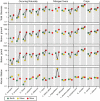Can plants grow on Mars and the moon: a growth experiment on Mars and moon soil simulants
- PMID: 25162657
- PMCID: PMC4146463
- DOI: 10.1371/journal.pone.0103138
Can plants grow on Mars and the moon: a growth experiment on Mars and moon soil simulants
Abstract
When humans will settle on the moon or Mars they will have to eat there. Food may be flown in. An alternative could be to cultivate plants at the site itself, preferably in native soils. We report on the first large-scale controlled experiment to investigate the possibility of growing plants in Mars and moon soil simulants. The results show that plants are able to germinate and grow on both Martian and moon soil simulant for a period of 50 days without any addition of nutrients. Growth and flowering on Mars regolith simulant was much better than on moon regolith simulant and even slightly better than on our control nutrient poor river soil. Reflexed stonecrop (a wild plant); the crops tomato, wheat, and cress; and the green manure species field mustard performed particularly well. The latter three flowered, and cress and field mustard also produced seeds. Our results show that in principle it is possible to grow crops and other plant species in Martian and Lunar soil simulants. However, many questions remain about the simulants' water carrying capacity and other physical characteristics and also whether the simulants are representative of the real soils.
Conflict of interest statement
Figures




References
-
- Stevens CJ, Manning P, van den Berg LJL, de Graaf MCC, Wamelink GWW, et al. (2011) Ecosystem responses to reduced and oxidised nitrogen inputs in European terrestrial habitats. Environmental Pollution 159: 665–676. - PubMed
-
- Palomba E, Zinzi A, Cloutis E-A, D'Amore M, Grassi D, et al. (2009) Evidence for Mg-rich carbonates on Mars from a 3.9 lm absorption feature. Icarus 203: 58–65.
-
- Muller O (1974) Solar wind nitrogen and indigenous nitrogen in Apollo 17 lunar samples. Proc. Lunar Sci. Conf. 5th, Vol. 2, 1907–1918. Pergamon Press.
-
- Parnell J (2005) Extraction of organic signatures from carbonates and evaporites: from mineral deposits to Mars. Proceedings of the Geologists Association 116: 281–291.
-
- Brack A, Pillinger CT (1998) Life on Mars: chemical arguments and clues from Martian meteorites. Extremophilest 2: 313–319. - PubMed
Publication types
MeSH terms
Substances
LinkOut - more resources
Full Text Sources
Other Literature Sources
Miscellaneous

